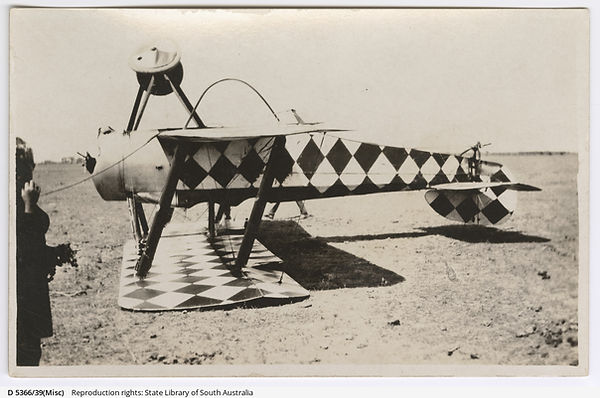

Clare's Early Aviation
The Areas' Express (Booyoolee, SA) Fri 14 Jan 1921 Page 3
— CLARE. Jan. 10. 1921
After a spell of hot, sultry weather a pleasant change has set in , making life much more contented, and not many complaints are heard about the oppressive heat.
Aviation has got quite a hold locally, and on Sunday last a large number of people visited the Clare race course to witness the arrival of Lieutenant Cooper with Mr. Dudley T . Angas by plane.
The (Sopwith Dove) machine (see below) is at present at Hill River (Station), and has been purchased from Mr. Angas by the Aviation Company, and it is generally believed that a central station will be established at Clare.
Quite a number of local people took a fly and all were delighted with the new means of locomotion, and so high above (land) that speed limits are as yet exempt.
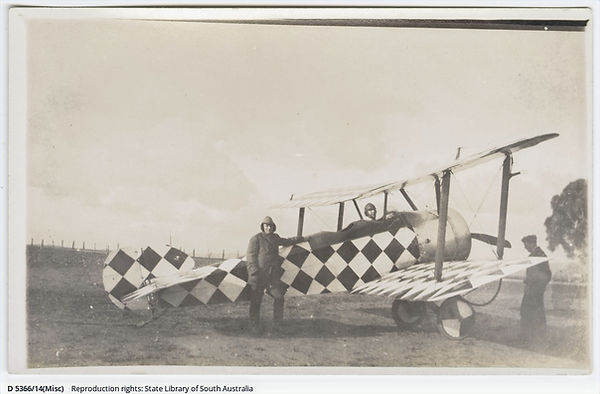
July 1920: Captain Loftes & R.F. Rogers "Sopwith Dove" - belonged to Dudley Angas.
This plane was rebuilt or replaced in Melbourne after an accident near Keith in August 1920.
The Dove was a post-war civilian airplane and is known for its distinctive upper swept-back wings.
Motor car carrying Mr. Dudley Angas of Hill River Station, South Australia, and Captain Vigers, M.C., D.F.C., (pilot), in the back seat.
The men arrived at Glenelg from Melbourne following a five and a half hour flight in a Sopwith Dove on 26 August 1920.
First Clare Flight:
Captain Vigers flew Angas back from Adelaide to his Hill River Clare property on 3 September 1920. (read much more at SAAM) (Plane sold to Major Cowper)
Major Cowper to Clare
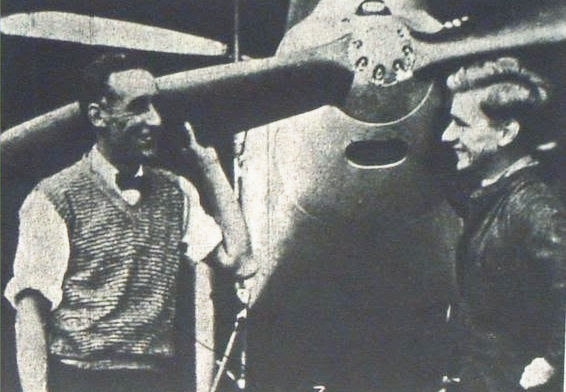
Major G.A.C. Cowper, a pilot, talking with assistant ground engineer at Mangere N.Z., Mr. L. Anderson, October 9, 1929
Register (Adelaide, SA), Friday 3 December 1920, page 7
COMMERCIAL AVIATOR'S FEAT.
Mr. Howard Jolley (Chief Inspector of the Life Insurance Company of Australia) arrived in Adelaide by aeroplane from Melbourne at about 5 o'clock on Thursday afternoon.
He was accompanied by Major G. A. C. Cowper, O.B.E., R.A.F., who piloted the machine. The journey was accomplished in 5 1/2 hours' actual flying time.
The two airmen departed from Melbourne at 7 o'clock and had breakfast at Horsham, where they remained a couple of hours. Continuing the journey, they proceeded to Serviceton, where they had lunch and stayed two hours before completing the air voyage to Adelaide.
The aircraft is an F.E. 2 B., with a 160 Beardmore engine. Prior to coming to Australia, this aeroplane was used extensively in France for night bombing.
Second Clare Flight
Mr. Jolley stated on Thursday evening that he would leave to-day by air for Clare, in company with the South Australian manager of his company (Mr. M. L. Arnold).
He proposed, he said, to depart from Adelaide at about 11 o'clock, and to land on the Clare Racecourse shortly after noon.
Major Cowper, who is on his first visit to South Australia, remarked that he was much impressed with the picturesque approach to Adelaide over the Mount Lofty Ranges.
Sopwith Dove 80 HP Le Rhone. Albert Park (Vic) January 1921. with Major Cowper, and Mrs Sydney Ayers of Clare
Hanley Sopwith Dove to normal way up, January 1921

Distant view of spectators which include Major G.A.C. Cowper, pilot of Aviation Limited, and passenger Mr. E.A. Brooks standing with their Sopwith Dove aircraft in a paddock near Adelaide, after their return from a trip to Marree and pastoral properties in northern South Australia, March 1921.
Herald (Melbourne, Vic.), Monday 18 September 1922, page 6
10,000 MILES BY AIR
Melbourne Pilot's Activities 300 PLACES VISITED
Major G. A. C. Cowper who has the reputation of being "one of the most skillful" cross-country pilots In Australia, has a unique record, inasmuch as he has never had a mishap of any kind in his flying career.
He has just terminated a six months contract with an enterprising insurance company which engaged him to carry one of Its representatives to the country districts of Victoria and the "back" country of New South Wales and South Australia (see below).
The machine used was a 90 HP R.A.F. engined Boulton and Paul which is the property of the company. During the series of aerial tours, some 10,000 miles were down, and 298 landings were made (see more below).
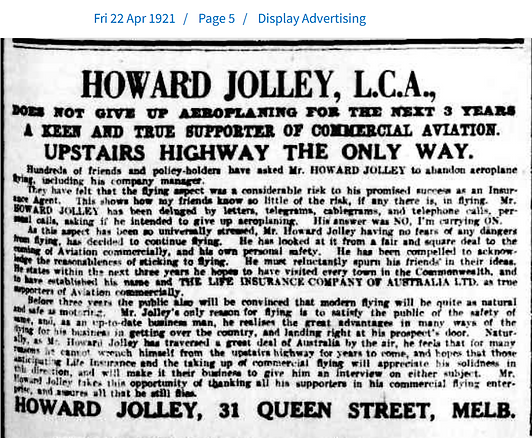
Regd. (C.of R. 72) 4.11.22 to Howard O Jolley, Adelaide.
Crashed after hitting car on take-off, Serviceton, Vic 8.11.22
Jolley was involved in numerous air-crashes for the next ten years. Photographs and newspaper cuttings related to these, along with dinner invitations, etc., are pasted into the book titled 'Newspaper Cuttings'. Entries into the book finish shortly before his death as a result of an air crash in 1931.
From the collection of Bendigo Historical Society Inc.
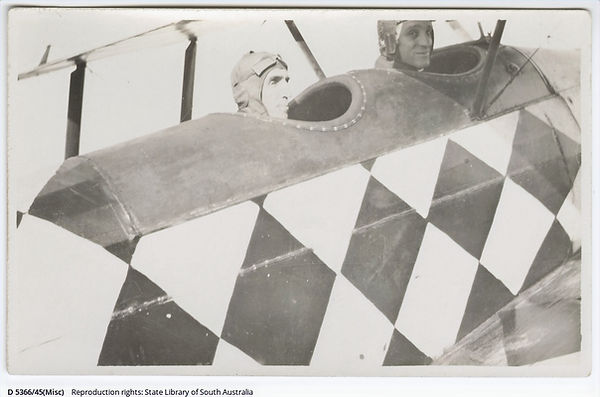
June 1921: Lt Lory & Clare mechanic Hobart Cato in the Sopwith Dove.
In 1921 Hobart was flight mechanic to Lieutenant Long in the record breaking flight Adelaide to Melbourne in the De Haviland Dove aircraft.
Blyth Agriculturist (SA) Fri 1 July 1921 Page 2 CLARE BOWLING CLUB.
Flight Commander Long was the first aviator who flew from Melbourne to Tasmania, and he flew Mr. D T Angas to Adelaide last Sunday in the Sopwith Dove recently seen a good deal in this town, and made a good trip.
Lieut Long flew on Monday with Mr. H. Cato (Vivian Lewis' mechanic and expert oxy-acetylene welder) to Wolseley in 2 hours, the next day they flew to Melbourne in 2 1/4 hours from Wolseley, making the flying time to Melbourne 4 1/4 hours, which to date, is a record between these cities.

Francis Stewart Briggs (left inset) and Clement John de Garis (right inset) in front of their Boulton and Paul P9 aircraft, July 1920
Northern Argus (Clare, SA : 1869 - 1954), Friday 4 February 1921, page 5
Aviation, so far as it has been made use of in the commercial world of Australia, is only in its infancy.
Third Clare Flights ?
Mr C J DeGaris, (Clement John de Garis, the energetic young managing director of the Sunraysia dried fruit business at Mildura), is practically the pioneer of commercial aviation, and he has demonstrated in his various flying trips to the Australian capitals the great saving of time and expense to busy business men that may be effected by the use of the aeroplane.
In a smaller way this has been demonstrated, too, in Clare lately.
As everyone in the district now knows, Aviation Ltd, have established a branch in Clare, with Major Cowper as flying manager, and Vivian Lewis, Ltd, as agents.
On Wednesday of last week Major Cowper brought Mr. Crosby. M.P. managing director of Vivian Lewis, Ltd, to Clare from Adelaide, and allowing time for him to transact business in Clare, landed him back in Adelaide within 2 1/2 hours.
On Thursday of last week the same aeronaut brought Mr. R E H Hope to Clare from Adelaide, leaving the city at 10,10 a.m. and reaching Clare at 11 a.m., thus taking only 60 minutes for the trip.
The same day at 11.30 a.m. he left for Adelaide with Sir S H Ayers as passenger, and arrived at his destination at 12.83. He returned the same afternoon with Mr, Ayers, leaving Adelaide at 6 p.m. and reached Clare at 7 p.m.
It can be seen from this what a boon aviation will prove to business men or commercial travellers.
On Saturday Major Cowper gave flights at Koolunga, when 14 people availed themselves of the opportunity of 'going up,' while at Brinkworth on Sunday 29 persons took their first flights in an aeroplane.
During the time Major Cowper has been here close upon 100 people have availed themselves of the opportunity of taking a flight. On Friday and Saturday this week Major Cooper will give flights at Spalding, and at Clare on Sunday, from 6 to 8 p.m. on each occasion.
Kingsford Smiths Acclaimed
The Advertiser Greg Barila August 8, 2017
IN 1919, two South Australian brothers, Ross and Keith Kingsford-Smith, pulled off a feat that world aviation experts now say was every bit as awesome in its day as man landing on the moon.
The Smith brothers, with Ross as pilot and Keith as navigator, pulled off an achievement some say was every bit as momentous in its day as man landing on the moon when they became the first Australians in history to fly a route from England to Australia.
And they did it against the elements, sitting in an open cockpit on a small wooden bench, with no way to communicate with the ground and nothing more than a compass to fix their long and dangerous journey.
The incredible feat was motivated by a 10,000 pound prize by the Australian government for the first all-Australian crew to make it from The Mother Country to Port Darwin in a British-made aircraft.
The Smith crew beat out four other daring Aussie teams to win the race in 11,500 miles (18,500km), 27 days and 20 hours.
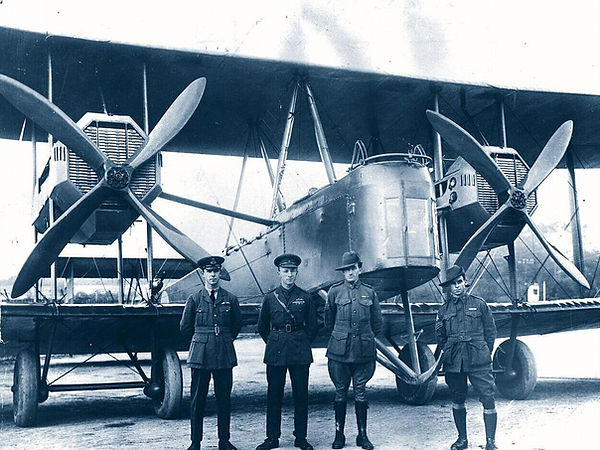
Left to right: pilots Lieutenant Keith Smith and Captain Ross Smith, with mechanics Sergeant James Bennett, and Sergeant Wally Shiers, standing by the Vickers Vimy G-EAOU at Hounslow Heath, England, at the start of the England to Australia flight.
Northern Argus (Clare, SA), Friday 21 May 1920, page 3
The Great Flight.
Sir (Ross) Keith Smith's Descriptive Lecture.
In the (old) Clare Town Hall, Sir Keith Smith will relate in full detail the stirring story of the memorable and epoch-marking aerial journey from London to Australia.
The film depicting the incidents of the journey will be shown. Great interest is being taken in all parts of Australia in the famous aviator's lecturing tour, and Adelaideans were fortunate in having the first opportunity to hear him.
The Prime Minister (Mr. Hughes), in moving a vote of thanks at the conclusions of Sir Ross Smith's lecture to members of the Federal Parliament at Federal Parliament House on Thursday, April 29, said: — "We have listened to a splendid description of an historic flight — an event that will live in the minds of all those who love feats of daring and adventure, who realise what the world owes to pioneers who go out and dare, as long as men and woman shall live."
"I said in this place, when welcoming Sir Ross Smith, that he and his companions had added new lustre to the name of Australia.
We have seen unrolled before us in brief panoramic form aided by that description of which Sir Ross Smith is a master, we have seen half the world, and half the world spanned in thirty days and less, by these Australians of whom we are so proud.
-
We are glad it has fallen to the lot of Australians to make this historic flight.
-
We are glad it has fallen to the lot of Australians to make the greatest flight in the air.
-
We have been pioneers in many things. We have been pioneers in this."
"We owe you, sir (Sir Ross Smith) and your companions a great debt. You have done this country a great honor, and anything that we can do for you will be inadequate payment for all you have done for your fellow-citizens.
I thank you on behalf of those present. I tender you our very heartfelt thanks, and I invite all to join with me by according it with acclamation."
Matinee at 3.30 ; night at 8. Plan at Argus office.
CHARLES Kingsford Smith (born in Brisbane, grew up in Sydney) is, rightfully, remembered as a legend in the history of Australian aviation.
But over the decades, Smith’s fame has overshadowed the daring efforts of the other pioneering aviation family with the Smith name, South Australian brothers Ross and Keith.
After the war, Kingsford Smith piloted joy flights and joined an aerial stunt team before setting up an aerial transport service in Australia.
The "Smith" associated with a 1927 record-breaking around-Australia circuit in just over 10 days was Charles Kingsford Smith, also known as "Smithy".
To generate publicity he and partner Charles Ulm achieved a series of aviation firsts. They completed a record-breaking around-Australia circuit in 10 days, 5 hours, with minimal navigational aids.
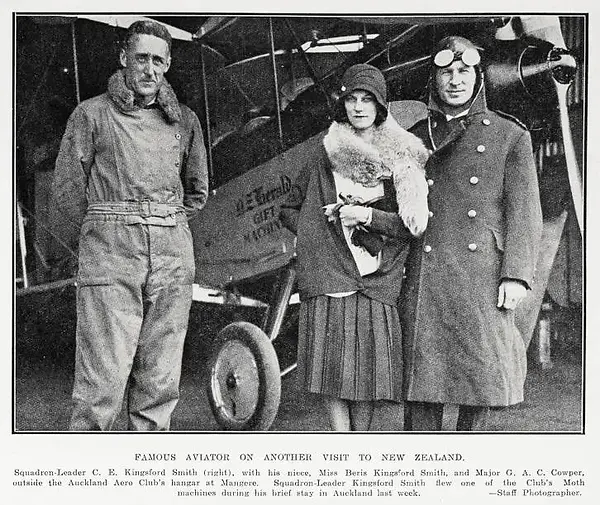

Charles (photos L&R ) piloted the first transpacific flight in 1928, flying from Oakland, California, to Brisbane, Australia, and the first flight between Australia and New Zealand.
In June 1928, Kingsford Smith, along with his co-pilot Charles Ulm and American crewmen Harry Lyon and James Warner, completed an extensive Pacific crossing by flying from Oakland, California, to Brisbane, Australia.
Charles Kingsford Smith, Charles Ulm, and their crew on September 10-11, 1928, in their Fokker trimotor aircraft, the Southern Cross, flew from Richmond, near Sydney, to Wigram Aerodrome in Christchurch, New Zealand, a journey that took 14 hours and 25 minutes.
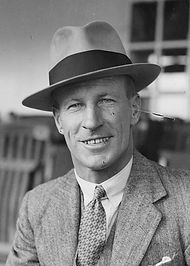
Northern Argus (Clare, SA), Friday 13 July 1928, page 5
KINGSFORD-SMITH FOR CLARE ON SATURDAY.
The Pacific crossing flight of Aviator Charles Kingsford Smith and his intrepid companions was eagerly watched by every person in Australia, and we may say the world, last month.
The wonderful feat of crossing the Pacific in three hops aroused the enthusiasm of everyone, and with commendable promptitude, Imperial Pictures announce the screening of the arrival of the four heroes in Brisbane, and Sydney, at the Clare Town Hall or Saturday.
The film shows wonderful close up views taken from an escort 'plane of the 'Fokker' monoplane and also intimate views of the aviators including that wonderful smile of Captain Kingsford-Smith.
The length of this topical film is well over 1,000 feet, and we can recommend the magnificence of this remarkable and historical subject to all.
Clare's Aerial View
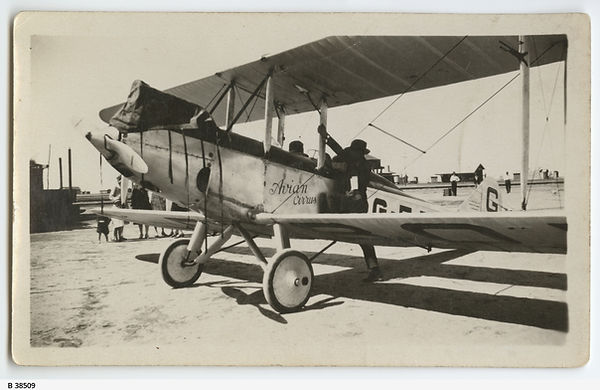
Avro Avian aircraft G-EBOV, flown by Bert Hinkler, at Cook S.A. on 30 March 1928 whilst enroute from Melbourne to Perth. Hinkler flew the same aircraft from England to Australia in February 1928.
Northern Argus (Clare, SA), Friday 18 May 1928, page 5
Aeroplane Visit.
It is anticipated that next Wednesday, 23rd. May, an aeroplane will visit Clare, provided suitable arrangements can be made for landing. Inspection is to be made both of the racecourse and Mr. Kimber's section opposite, and the consent of either owner obtained for the purpose above mentioned.
The flight is being made in the interests of the National Musical Federation Ltd., and passenger flights in the machine, an Avro Avian, similar to that used by Hinkler (below), will be possible for those who desire to see Clare from the air.

In 1928 the indefatigable Australian aviator Herbert (Bert) John Louis Hinkler (1892-1933) made the first solo flight between England and Australia, using Avro 581 Avian G-EBOV.
Hinkler's machine after arrival in Australia (thought to be in Queensland).
Blyth Agriculturist (SA : 1908 - 1954), Friday 1 June 1928, page 2
FIRST AERIAL PHOTO OF CLARE IS A WONDERFUL SUCCESS.
When the Avro Avian 'plane I visited Clare last week, Mr. L. G. Sladdin made a long flight over the town and district, and secured for Mr. S. T. McLean a wonderful film of Clare from the air (see below).
This film-will be included in "The Back to Clare" film which is now practically complete.
The excellence of the finished film far exceeded the expectations of the local cinema producers, who are naturally very jubilant over the success of their first aerial photography venture.
The pilot, of the plane, Flight-Lieut Shoppee, paid a wonderful compliment to Mr. Sladdin, and strongly advised him to take up the study of aviation, as his natural coolness in the air for his first flight was remarkable.
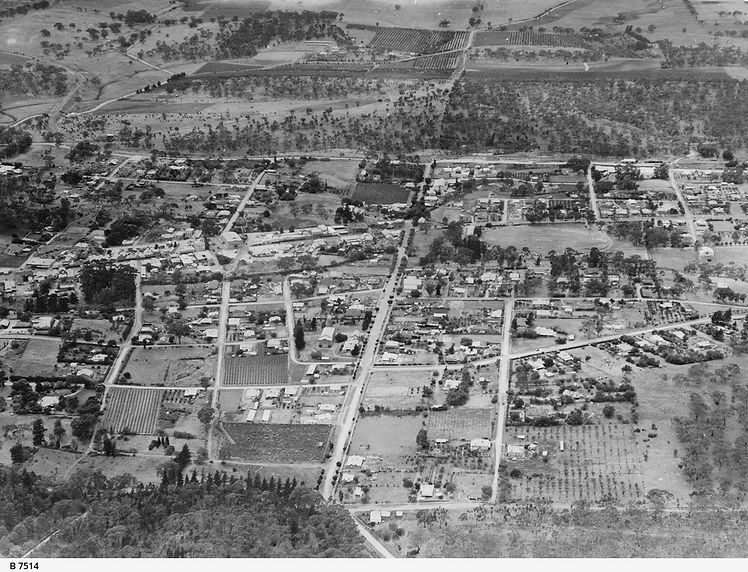
Aerial view to the East of Clare showing the surrounding hills and vineyards near the township (1938). The new Town Hall is situated centre left.
The Hutt River winds its way from top right to centre left.
Capt. Grosvenor as Aviator
Captain the Hon. Hugh Raufe Grosvenor:
-
(1904-1930), Aviator; Second Lieutenant
-
Was a son and heir of Lord Stalbridge, a British Peer.
-
He was 25 years of age, an old Etonian, and captain on the reserve of the Seventh Hussars.
-
Role: He was appointed as an Aide de Camp to the Governor of South Australia, Sir Alexander Hore-Ruthven.
-
Significance: He was the first person to fly solo around Australia in 1929.
-
Tragedy: He died in a plane crash at Point Cooke in January 1930 at the age of 25.

Register (Adelaide, SA), Friday 12 October 1928, page 10
Capt. Grosvenor as Aviator.
Captain the Hon. Hugh Grosvenor, A.D.C. to His Excellency the Governor, returned to Adelaide on Thursday afternoon, after a flying trip to Angorichina Station, in the far north.
Capt. Grosvenor is the owner of a 'Moth' light aeroplane, which he pilots himself, and his trip on the present occasion shows what distances can be covered n a short time by a machine of this class.
Accompanied by Mr. R. Lee, a son of Mr. J. Lee, the owner of Angorichina, Capt. Grosvenor left the Parafield Aerodrome at 5 minutes past 7 o'clock on Tuesday morning.
Hawker, which is about 210 miles from Adelaide, was reached in 2 hours, 40 minutes.
After taking in a fresh supply of petrol, the flight was resumed; and Blinman, 75 miles distant, was reached at a quarter to 12 o'clock.
Capt. Grosvenor spent the night at Blinman with Mr. Lee, and. during his stay, found time to drive to Angorichina and inspect the hostel there.
At 4.55 p.m. on Wednesday the return trip was commenced, and the aeronaut reached Hawker at 5.40 p.m., and stayed the night there.
At 10.30 o'clock yesterday morning, the machine took off, and a course was steered for Clare, where a good landing was made at 12.10 p.m.
Luncheon was partaken of at Bungaree and at 4 p.m. the journey was resumed, and aided by good weather conditions.







